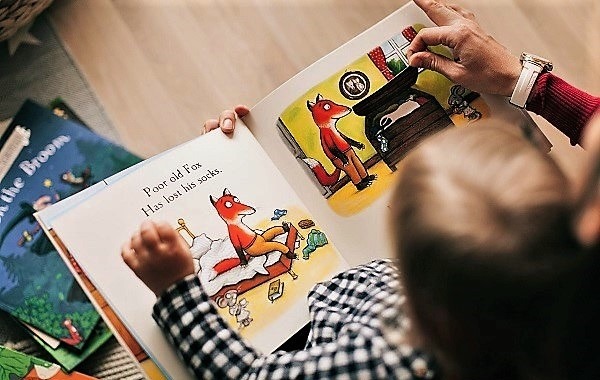
Preschool reading may be the single most important activity parents do with their child.
It is never too early to begin teaching your child to read, or at least laying the foundation for early learning skills! That’s because a child who is read to is more likely to enjoy reading and will want to learn to read.
Once a child becomes passionate about reading- she will have the opportunity to enjoy a lifetime of learning.
When my kids were toddlers, every day I got them excited about preschool reading. It was a special time when all was calm and quiet. And the story was the only thing that mattered.
Ø Preschool Reading Is Fun And Fundamental
One of the best, most enjoyable things you can do with your kids, is to read to them.
This is a great way to connect with them and to share different parts of your life story in a natural, easy, and relaxed setting.
Most children begin learning to read during a profoundly formative phase in their development. As they begin learning to read, they’re also learning to think abstractly. They are learning to learn and they’re experiencing emotionally charged feelings about who they are and how well they are learning.
Did you know that for a significant part of their childhood, your kids’ intellectual capacity will be greater than their reading ability? That means that they can understand the material when it is read aloud to them that they would not be able to read.
Interesting isn’t it?
Parenting can be a stressful experience at times, and you might not have the chance to indulge in traditional learning activities. But you can spend more time with preschool reading activities that actively involve your kids.
8 Sneaky Ways To Help Your Preschooler To Read
There are numerous ways to share books with your little one. Your reading skills do not have to be top notch. Just the one-on-one time alongside your little one is making a difference to them. The closeness and sharing of stories will pay off for years to come.
One of the most important tips in regards to teaching your child to read is to simply make time for it. How can you as a parent create a reading schedule for each child, and a location that works for everyone involved?
1. Read to your little one every day.
You need to radiate an excitement about reading a story together so that your child thinks of reading as fun. There are a few ways to make reading fun. You can talk or sing about the pictures in the book.
You don’t have to read it word for word. Occasionally it is more intriguing to add your own twist to a story.
Talk about your own relatives or friends and add their names to the story.
2. Read It Twice
When your child is ready to tackle the passage alone, allow him (or her) to read it to you twice. Give him an encouraging smile, but be cautious not to step in and interrupt.
By allowing him this time to read back to you, it builds self-confidence in him and finalizes the learning process.
3. Ask questions about the pictures in the book
Let your little one create their own take on the story. They may see the pictures speaking to them a bit differently than what the words depict. This will open up a vast dialogue and a chance for you to elaborate on things in the pictures and assist your child in discovering the world we live in.
4. Show your children the cover of the book
Let them recite to you what they believe the book is about. If they are too young to do so, point out certain items in the pictures to help them learn the names of the characters that might be in the pages that follow.
5. Encourage your preschooler to read in funny voices
Parents at times feel uneasy reading to their children. It could be for numerous different reasons. Perhaps they don’t take to reading themselves. Possibly their reading skills are not the best. Or maybe they feel like they have to produce comical faces and make un-natural sounds in order to read a little one’s book. So for fear of embarrassment, they pass on the reading assignment.
6. Let your little one turn the pages of the book for you
This will help them interact with the book and get familiar with how books are laid out.
Children have a short attention span, so don’t get discouraged if they lose interest before you are finished reading the book.
7. Have fun with reading
Remember to have fun with reading, and your child will pick up on this positive reinforcement of reading.
Reading gives you a unique viewpoint, often from right inside the character’s mind. This helps you to see the world through eyes other than your own.
8. Use Larger Words
When speaking to your baby, use a wide variety of words in your vocabulary. Don’t be afraid to include words that are difficult to pronounce or understand. Using big words encourages an expansion of your baby’s vocabulary, and he will understand them as he grows.
Common Preschool Reading Mistakes and How to Fix Them
Preschool reading is a challenge for many young children. There are a number of common errors that are made when learning to read, but there are ways to correct them before they become ingrained in your child’s reading. Here are some of the more common reading mistakes, and how you can fix them as soon as they appear.
1. Preschooler mixes up sounds within a word
child mixes up sounds within a word. It indicates that they are not tracking left to right, which is the proper way to read. They might sound out a letter near the end of the word before one nearer to the beginning. To help your child in this situation, sound out the word from left to right, and move your finger in the proper direction to help them remember this.
2. Word Guessing
Often when a child learns to read, they may guess a word without viewing it in its entirety. If a child makes the correct sound of the first letter, but the rest of the word is wrong, they may be doing this. Watch your child’s eyes closely, as children who are word guessing often look away from the page and list a string of possible words while watching you to see how you react. Again, sound out the word for your child while pointing at the letters and letter combinations.
9. Trouble with Vowel Combinations
Children may struggle combining vowels. You will realize this if their vowel combinations sound choppy or do not flow properly. If your child is having difficulty putting two vowels together, practice sounding out the vowel combinations, or make up a catchy rhyme or poem to help them remember what the combination sounds like.
10. Lack of Attention to Detail
When a child is in a hurry to read, or has trouble concentrating, they may lack attention to detail. If your child misses parts of a word they are attempting to read, or skips words, this may be the issue. They may have trouble blending consonant clusters. Encourage your child to slow down and take their time in order to conquer this problem.
11. Confusing the Letters
It is a common issue for children to confuse letters when they are beginning to read. Letters such as b, d, and even p which are similar in shape can cause confusion among early readers. If your child is obviously mixing up their letters, have them print each letter numerous times in regular block style print.
12. Memorizing the words
Sometimes children learn tricks that make them appear to be reading better than they actually are. This can be deceiving to those who are instructing them, as the child appears not to have any struggles.
If you notice your child reciting a portion of reading to you and they are not even looking at the book, they have likely memorized it.
The way to combat this is to have your child read new books often and to avoid books with pictures that give away what is written once they have read it through.
There are many common mistakes a child may make while learning to read. If you catch them early, you can correct them so that they will not become a long-term stumbling block to your child. Your young reader will benefit from your attention as you keep your eyes out for these common reading mistakes and assist your child in conquering them.



